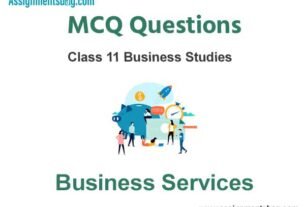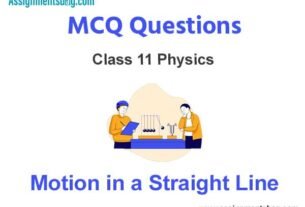Please refer to MCQ Questions Chapter 1 Physical World Class 11 Physics with answers provided below. These multiple-choice questions have been developed based on the latest NCERT book for class 11 Physics issued for the current academic year. We have provided MCQ Questions for Class 11 Physics for all chapters on our website. Students should learn the objective based questions for Chapter 1 Physical World in Class 11 Physics provided below to get more marks in exams.
Chapter 1 Physical World MCQ Questions
Please refer to the following Chapter 1 Physical World MCQ Questions Class 11 Physics with solutions for all important topics in the chapter.
MCQ Questions Answers for Chapter 1 Physical World Class 11 Physics
Question. Atomic and molecular phenomena are dealt with by
(a) Newtonian Mechanics
(b) fluid Mechanics
(c) applied Mechanics
(d) Quantum Mechanics
Answer
D
Question. Which of the following is a possible final step in applying the scientific method
(a) Formulating a hypothesis
(b) Building a theory
(c) Analysis of test results
(d) Formulation of a question
Answer
C
Question. The scientific method is
(a) a prescribed method for investigating phenomena, acquiring new knowledge.
(b) A procedure for proposing new hypothesis
(c) a body of techniques for investigating phenomena, acquiring new knowledge.
(d) A method for proposing new theories.
Answer
C
Question. Newtonian mechanics could not explain
(a) fall of bodies on earth
(b) Some of the most basic features of atomic phenomena.
(c) movement of planets
(d) flight of rockets
Answer
B
Question. Heliocentric theory proposed by Nicolas Copernicus was
(a) replaced by circular orbits to fit the data better
(b) replaced by elliptical orbits to fit the data better
(c) replaced by elliptical orbits to fit the taste of new rulers of Italy
(d) replaced by parabolic orbits to fit the data better
Answer
B
Question. Which of the following is a possible first step in applying the scientific method
(a) Conducting tests
(b) Formulating a hypothesis
(c) Formulation of a question
(d) Building a theory
Answer
C
Question. A scientific theory
(a) cannot be changed but can be reformulated
(b) is fixed once and for all because it is logical
(c) is changed to suit new fashion among scientists
(d) can be revised if required to fit new phenomenon or data
Answer
D
Question. Newtonian mechanics could not explain
(a) fall of bodies on earth
(b) Some of the most basic features of atomic phenomena.
(c) movement of planets
(d) flight of rockets
Answer
B
Question. Physics is a
(a) Applied Science
(b) Mathematical Science
(c) Engineering Science
(d) Natural Science
Answer
D
Question. The word Science originates from the Latin verb Scientia meaning
(a) to know
(b) to see
(c) to experience
(d) to observe
Answer
A
Question. Just as a new experiment may suggest an alternative theoretical model, a theoretical advance may suggest what to look for in some for in some experiments. Which of the following experiments can be considered to support this claim?
(a) Davisson and Germer Experiment
(b) experimental discovery of positron
(c) scattering of alpha particle or the gold foil experiment
(d) Michelson Morley experiment
Answer
B
Question. Just as a new experiment may suggest an alternative theoretical model, a theoretical advance may suggest what to look for in some for in some experiments. Which of the following experiments can be considered to support this claim?
(a) Davisson and Germer Experiment
(b) experimental discovery of positron
(c) scattering of alpha particle or the gold foil experiment
(d) Michelson Morley experiment
Answer
B
Question. Physics is a
(a) Applied Science
(b) Mathematical Science
(c) Engineering Science
(d) Natural Science
Answer
D
Question. Atomic and molecular phenomena are dealt with by
(a) Newtonian Mechanics
(b) fluid Mechanics
(c) applied Mechanics
(d) Quantum Mechanics
Answer
D
Question. Which of the following is a possible final step in applying the scientific method
(a) Formulating a hypothesis
(b) Building a theory
(c) Analysis of test results
(d) Formulation of a question
Answer
C
Question. The word Science originates from the Latin verb Scientia meaning
(a) to know
(b) to see
(c) to experience
(d) to observe
Answer
A
Question. Heliocentric theory proposed by Nicolas Copernicus was
(a) replaced by circular orbits to fit the data better
(b) replaced by elliptical orbits to fit the data better
(c) replaced by elliptical orbits to fit the taste of new rulers of Italy
(d) replaced by parabolic orbits to fit the data better
Answer
B
Question. Which of the following is a possible first step in applying the scientific method
(a) Conducting tests
(b) Formulating a hypothesis
(c) Formulation of a question
(d) Building a theory
Answer
C
Question. Wave picture of light failed to explain.
(a) the photoelectric effect
(b) polarization of light
(c) diffraction of light
(d) interference of light
Answer
A
Question. The scientific method is
(a) a prescribed method for investigating phenomena, acquiring new knowledge.
(b) A procedure for proposing new hypothesis
(c) a body of techniques for investigating phenomena, acquiring new knowledge.
(d) A method for proposing new theories.
Answer
C

We hope you liked the above provided MCQ Questions Chapter 1 Physical World Class 11 Physics with solutions. If you have any questions please ask us in the comments box below.

